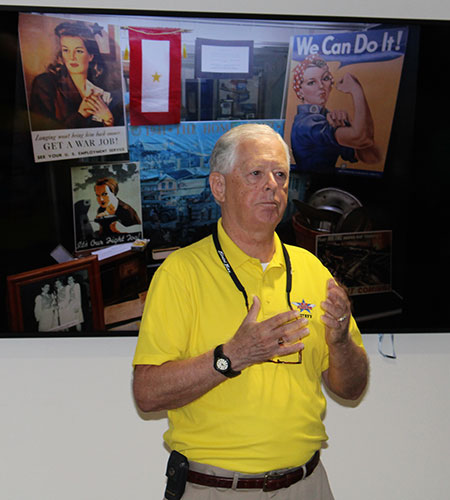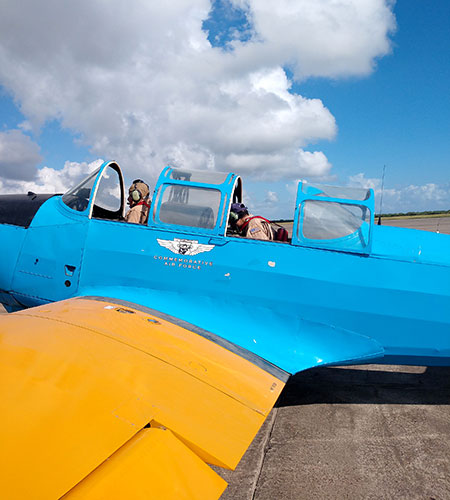 Editor’s Note: This story about the Commemorative Air Force will take place in two stories. This first part will give you a history and purpose for the CAF and what they do. Next week we will let you know how you can help them achieve their ongoing mission.
Editor’s Note: This story about the Commemorative Air Force will take place in two stories. This first part will give you a history and purpose for the CAF and what they do. Next week we will let you know how you can help them achieve their ongoing mission.
According to Commemorative Air Force history, the CAF started with just a single plane, right here in the Rio Grande Valley. Lloyd Nolen, a crop duster pilot that had recently returned from WWII, and a small group of ex-service pilots pooled their money together to purchase a P-51 Mustang in 1957. Together they formed an organization to share the expense of maintaining the Mustang and their love for the plane.
In short time, through their efforts, the group eventually added a pair of F8F Bearcats to the collection. It was then they realized what they needed to do – save the aircraft that saved the world. They created what is now the Rio Grande Valley Wing Museum of the CAF – now a worldwide organization with over 10,000 members in 75 wings/detachments and over 150 planes, known as the Ghost Squadron, and other vehicles from WWII, Korea and Vietnam. They now operate the largest fleet of historic combat aircraft.
America had produced nearly 300,000 aircraft by the end of the war. By 1960, most of the planes from the WWII era were gone – destroyed, lost, in great disrepair, and forgotten. Most, what remained, were empty shells, stripped of wiring, armament and instruments; others were broken up, crushed for scraps or smelted. As CAF says, “all radio channels of their crews faded away.”
What started as a hobby for these few men, grew to an urgent mission to save history. The survivors were few, and Nolen, and his group, were eager to have their stories known. They set out to try to preserve one of every type of plane from WWII. Once they began finding planes, it was their goal to restore and bring history alive, to inspire greatness in future generations.
“Airplanes weren’t meant to sit on the ground and to sit at museums gathering dust,” said the CAF.
“Rather, they should be seen in their natural environment through flight. Their engines rumbling, propellers turned to life, their wings shivering in anticipation for flight. These machines were meant to fly, to inspire, and to fulfill the humans desire to dance among the clouds.”
Today, among their collection, the CAF owns one of the only remaining flying Boeing B29 super Fortress Bomber (FiFi) and the Curtis SB2C Helldiver carrier base dive bomber; an original Japanese Mitsubishi A6M30 carrier-based fighter; and a Russian I16 Polikarpov fighter.
With their collection, the CAF dedicated each Wing to have a different collection of aircraft, a different specialty. The RGV Wing has trainer aircraft from WWII and a few vehicles as well.
“The history and service of the men and women who flew these airplanes are both compelling and inspiring,” says the CAF.
Tom Santos, Executive Officer of the RGV Wing, said it takes a lot to be a pilot. You must know more than just how to fly planes. There is a special certification one needs to fly these planes. Once certified, pilots keep a logbook on how much they fly and when to make sure they put in their flights hours and the planes get the airtime they need.
Chris Hughston, operations manager at the RGV CAF, said there is an intense culture of safety when it comes to flying the planes. For example, anyone that flies in one of the airplanes must wear one of the real flight suits. They are fire retardant, not fireproof, and will buy you an extra 30 seconds to a minute if you are in open flame. It will also keep burning things off you – like oil and gas.
Hughston pointed out that a lot of the maps they use today are some of the same they used so many years ago. What they have started incorporating though, is having the same map on tablets, versus the paper. This allows them to see more than what is on paper, like navigation and radar overlay. Being that most of the planes are open cockpit, a paper map can be lost very easily when you are trying to read the chart/map and keep your hands on the controls.
He recalled flying their oldest plane, a 1928 bi-plane – it was a beautiful day as he was getting ready to land when the aircraft’s registration, an index card sized piece of cardboard, came flying out of the airplane, hitting him in the face.
“It was not a pretty landing,” he said, and there were many people that were witness to that. His registration card ended up out on the runway.
He laughed saying that when you come in and do a beautiful landing, there is no one around to see, but when you mess up, all of the sudden everyone is out there watching.
The CAF can use anyone he said. You don’t have to be a pilot to help at the CAF. Ground help is needed as well. There is other antique machinery at the airport. They have trucks, jeeps, support equipment and a 1928 Model-T – which is a two-owner vehicle getting its engine rebuilt for the second time.
The CAF has created an educational traveling exhibit and series called Rise Above that feature’s unsung heroes such as the Tuskegee Airmen and WASP. These are stories that are shared in the hopes of inspiring others to rise above their differences, their challenges, to achieve their goals.
The CAF says the stories shared in their exhibits are only the beginning.
“It’s only limited by the number of untold stories of valor” in America’s aviation history.
The American Air Powered Heritage Museum in New York, a visitor can see the single largest collection of authentic WWII aviation nose art, cut by firemen axes and chainsaws from the fuselages of derelict army air force bombers awaiting demolition in 1946. This display shows the folk art of how the pilots and crew members personalized the very aircraft in which their lives depended on during the war.
The RGV Wing has its own museum as well. Although space is limited, there are quite a few things to look at. These are artifacts that have been collected over time or have been donated by members or by local WWII vets and families. Tears were present as a member of the RGV CAF spoke about some of the artifacts they have in their museum.
The museum curator, David Christopher, shared stories of some of the artifacts and how they got there or what they have meant to visitors.
An older couple came into the museum and the wife was startled. She started crying, said Christopher. When the couple approached a certain display, the wife had to walk away and compose herself.
The display contained a picture of a bomber with his crew. One of the volunteers at the time, found out that the picture had the lady’s her ex-husband in it. He had left to fight in the war and did not return alive.
Christopher said he must do quite a bit of research on how to take care of some of the artifacts they have. One thing he has researched is how to take care of leather since they have several leather jackets on display.

He was taking care of the jacket when he realized there was something in one of the pockets. He gently reached into that pocket and found a bag of ashes. Checking on some of the displays and noticed a leather jacket that needed some extra care and he wanted to make sure it stayed preserved in the south Texas heat.
For a while, Christopher choked up and Santos had to help him continue the recollection.
A member had donated the jacket. When they talked to him, he told them it was the ashes of his father.
“His father wanted his ashes to stay with his jacket.”
They still have this jacket on display, with the man’s ashes safely in the pocket.
The RGV Wing is in Port Isabel at the Cameron County Airport. For more information, or to set up a tour, call Christopher at 970-397-4604 or Santos at 956-579-2611. Information can also be found on their website at www.rgvcaf.org.













